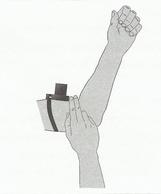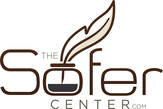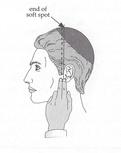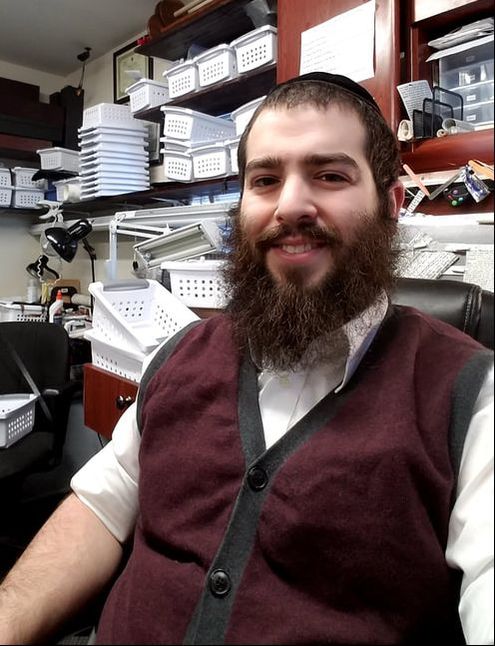 For the convenience of my clients when Tefillin are brought into be checked I provide them with a loaner set of Tefillin to use in the meantime, before they leave I have them try on the Shel Rosh in order to make sure it fits correctly. Yesterday I had someone bring in Tefillin to be checked, when he tried on the Shel Rosh I noticed how he pulled the Bayis down onto his forehead and the Knot was practically on his neck, which is problematic to say the least. I explained to him the correct placement for the Tefillin and he was surprised how no one had ever mentioned it to him he was ecstatic how he can finally start wearing Tefillin correctly! Shel Yad/Hand Tefillin The Tefillin Shel Yad is worn on the weaker arm, because there is a Limud from the posuk/verse in Parshas/(Torah portion) “Vehoyo Ki Yiviacho” which writes regarding the Shel yad that it is placed “al Yodchah”(on the arm) it is written with a seemingly extra letter hey after the chof , Chazal learn out from this “Yad Keho” which means “the weaker arm”. So for a right-handed person it is placed on the left arm and a left handed person wears the hand Tefillin on his right arm. Someone who is ambidextrous should wear it on his left arm. Someone who writes with one hand and all his other activities with the other should consult a Rav. The Titura of Bayis ( the base of the Tefillin) must rest on the center of the width of the biceps muscle and lean slightly toward the heart. The Shulchan Aruch and the Ramah hold that no part of it may rest and higher than the midpoint of the humerus bone -which is the bone that stretches from the shoulder to the elbow-. According to the Gra however it can go higher up, just no higher than the top edge of the biceps muscle. The lowest point that Titura may rest is on the lower edge of the biceps muscle, if it is any lower it is as if you are not wearing Tefillin. Now some hold that 1) this is determined when the arm is bent at an approximate 90 degree angle. 2) while others hold it is when the arm is outstretched and relaxed. You can determine its position by locating the base of the muscle with your finger and making sure that the front edge of the Titura is above it. As a general rule: If you can place your index and middle finger between the cleft of the arm and the front edge of the Titura when the arm is bent at an approximate ninety degree angle then it is most likely in the proper position according to the first opinion. And if you can place your pinky ring and middle fingers, then it is in the correct position according to the second opinion. As well the knot must be touching the Box the entire time you are wearing the Tefillin. Proper placement of Tefillin Shel Rosh The entire Bayis Shel Rosh(Head Tefillin) must rest above the original hairline which is determined by the hair roots of each individual person. If any part rests below, it is considered that the Tefillin are not being worn. Someone who’s hairline has receded should continue to place the entire Bayis shel rosh above his original hairline. If one looks closely at his forehead he can locate his original hairline as the part of the forehead where the hair once grew looks different then the rest of the forehead. In addition the Tefillin must be centered so that the middle of the bayis will rest directly above the bridge of the nose. The back edge of the bayis can reach until the top of the head, which is equivalent to the end of the soft spot on the baby’s head, this area can be identified by running the tip of ones finger straight upward from the front of the ear. Placement of the knot of the Shel RoshThe majority of the knot must rest on the center of the base of the skull, and the remainder of the knot may rest just below it in the indentation on the nape. Many people mistakenly think that the proper placement of the knot is completely in this indentation. If the knot is below the bone at the base of the skull then as long as the entire knot is above the hairline it is still acceptable. Tefillin straps tend to gradually stretch causing the bayis and knot of the Shel Rosh not to rest in their proper place, the straps of the Shel Rosh should be adjusted as necessary.
1 Comment
|

CASE STUDIES
Check out my YouTube channel for the latest updates Many things can render Tefillin or Mezuzah not Kosher or at best minimally Kosher. Some of these happen over time with aging and some unfortunately are Posul from the get go. Such as, Letters, words and or Tagim that are missing, extra substituted, touching, Broken, Improperly Spaced, misshapen faded, cracked and weather damaged. We document the problems we find and periodically upload them to the website. We hope that this will educate and encourage the public to purchase only Tefillin and Mezuzas that are high quality from a reputable source, to take care of them properly and have them checked regularly. Categories
All
AuthorRabbi Kass was ordained by Rabbi Yisrael Meir Lau, former Ashkenazik Chief Rabbi of Israel. He is certified as a Sofer for both Kesivah and Hagoah by one of the leading experts in Safrus, Rabbi Avrohom Tzvi Vosner, Rav of the Vad Mishmeres Sta”m. Archives
December 2023
|
What our clients say about us: |
To enhance our service quality, we operate on an appointment-only basis.
Please contact us to make an appointment. $12.99 Flat rate shipping! Mezuzahs, Tefillin & Accessories! |
|




 RSS Feed
RSS Feed




